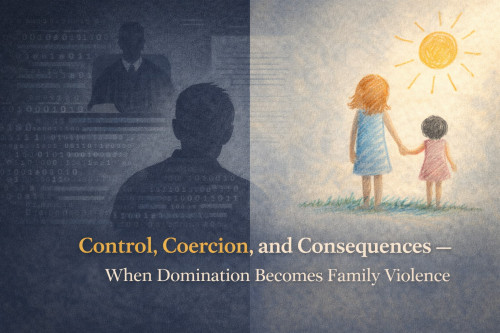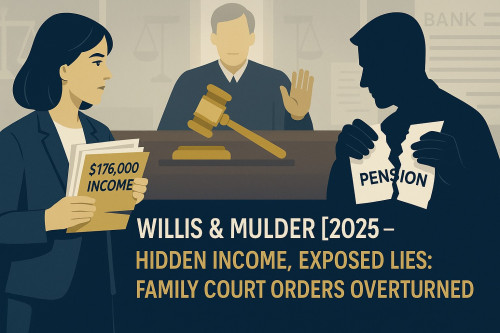Digests
Latest Posts

In Takenaka & Maddox [2025] FedCFamC1A 243, Justice Campton of the Federal Circuit and Family Court (Division 1) dismissed an appeal by a self-represented father who sought to overturn extensive parenting orders. The appeal arose from findings that the father engaged in a sustained, four-year campaign of intimidation, threats, and coercive control against the mother. Despite voluminous filings and claims of judicial error, the Court upheld the trial judge’s assessment that the father’s domineering behaviour and lack of insight rendered shared care unsafe. The decision underscores the judiciary’s increasing recognition of coercive control as family violence under s 4AB of the Family Law A
- · FLAST NEWS
- ·
In Conner & Conner (No.3) [2025] FedCFamC1A 235, Justice Schonell of the Federal Circuit and Family Court (Division 1) was asked to expedite an appeal concerning interim parenting orders. The mother (appellant) alleged that the child was at risk of harm in the father’s care and sought urgent consideration of her appeal. The Court, however, refused to grant expedition, finding that the appeal—already listed within three months—was effectively being fast-tracked and that no compelling basis existed to prioritise it over other pending appeals.Facts and Issues:The parties were engaged in protracted and highly conflictual parenting litigation under Pt VII of the Family Law Act 1975 (Cth).The
- · FLAST NEWS
- ·
In Provenza & Provenza (No 4) [2025] FedCFamC1A 232, the Federal Circuit and Family Court of Australia (Division 1) delivered a sharp procedural reminder: even when family violence findings are damning, judicial power must remain within statutory bounds. The father’s appeal succeeded in part—not because the trial judge erred in substance, but because she made injunctions under s 68B of the Family Law Act 1975 (Cth) that conflicted with an existing State family violence order (FVO). Justice Austin found that this overlap breached s 114AB of the Act, rendering three injunctions invalid. The case underscores the limits of concurrent federal and state jurisdiction in family violence protecti
- · FLAST NEWS
- ·
In Walshe & Walshe [2025] FedCFamC1A 231, Justice Campton delivered an important appellate decision clarifying the powers and responsibilities of family judges when assessing risk in interim parenting disputes. The Court confirmed that, even when evidence is untested or conflicting, judges are not prohibited from making factual determinations necessary to protect children. The decision affirms the judiciary’s duty to act cautiously but decisively in child-related matters — particularly where allegations of sexual abuse or family violence arise.Facts and IssuesThe mother alleged that the father posed an unacceptable risk to their daughter (born 2019) due to sexual abuse, family violence,
- · FLAST NEWS
- ·
The Federal Circuit and Family Court of Australia (Division 1) delivered a rare and scathing rebuke of solicitor conduct in Fing & Ma (No 2) [2025] FedCFamC1A 230. The Full Court found that the solicitor, Mr AQ of Aston Legal Group, had departed from objective professional judgment and acted under emotional and religious influence in urging a grieving client to pursue a hopeless appeal based on her late father’s suicide note. The solicitor was ordered to personally pay over $97,000 in costs on an indemnity basis — a stark reminder that legal advocacy must remain dispassionate, evidence-based, and client-centred.Facts and IssuesThe case stemmed from a failed property appeal brought by the
- · FLAST NEWS
- ·
How a father’s six-figure legal bill turned into a cautionary tale about fairness, restraint, and the limits of costs recovery in family law.In Langley & Mirza (No 2) [2025], Justice Austin delivered a sharp reality check for litigants pursuing large-scale cost recoveries in family law. Despite the father spending $252,235.91 in actual legal costs, he walked away with only $10,000 in costs on appeal — a stark illustration that family law costs are governed by proportionality, fairness, and reasonableness, not the magnitude of one’s legal bills.The case demonstrates that even where a party “wins,” discretion and equity control the outcome — not accounting spreadsheets or punitive motives.
- · FLAST NEWS
- ·
In Conner & Conner (No 2) [2025] FedCFamC1A 223, the Full Court of the Federal Circuit and Family Court of Australia reaffirmed a fundamental principle of appellate law — not every order is appealable. The mother’s attempt to appeal procedural directions relating to a psychiatric assessment was dismissed as incompetent because the orders did not determine any substantive rights. The Court’s reasoning underscores the distinction between procedural and final orders and the importance of understanding when an appeal properly lies.Facts and IssuesThe parties married in 2019 and have one child (born 2021).Following separation in 2022, multiple interim parenting orders were made allowing the c
- · FLAST NEWS
- ·
In Mertz & Mertz (No 3) [2025] FedCFamC1A 222, the Federal Circuit and Family Court of Australia took an unprecedented stance on the misuse of Artificial Intelligence in family law litigation. The case serves as a cautionary tale for legal practitioners about the unverified use of generative AI in preparing submissions. When counsel submitted documents containing fake authorities and inaccurate case citations, the Full Court not only ordered costs against the appellant but also referred the lawyers involved to their respective professional conduct regulators. This decision sets a critical precedent on technological responsibility and professional ethics in modern advocacy.Facts and Issue
- · FLAST NEWS
- ·
In Joustra & Schuman [2025] FedCFamC2F 1478, Judge Suthers delivered a decisive ruling in a highly contentious second tranche of parenting proceedings. The mother, who initiated the case, alleged the father had sexually abused their six-year-old son. However, after multiple investigations by police and child protection authorities found no evidence, the Court determined that the mother’s persistent and unsubstantiated allegations caused emotional harm to the child. In a rare but clear outcome, the Court found the mother — not the father — posed an unacceptable risk to the child’s psychological wellbeing, granting the father sole parental responsibility and ordering that the child live wi
- · FLAST NEWS
- ·

In Willis & Mulder [2025] FedCFamC1A 217, Justice Austin of the Federal Circuit and Family Court (Division 1, Appellate Jurisdiction) overturned a property settlement after the wife uncovered explosive new evidence — her husband, who claimed to be a pensioner with no income, had secretly declared a $176,000 annual salary to a lender just months later. The appellate court found that while the trial judge made no legal errors based on the original evidence, the husband’s post-trial loan documents “collided violently” with his sworn testimony. This new evidence fatally undermined the trial findings under s 75(2) of the Family Law Act 1975 (Cth), leading the Court to set aside the orders and
- · FLAST
- ·
In Barnabas & Phineus [2025] FedCFamC1A 215, Justice Campton of the Federal Circuit and Family Court of Australia (Division 1, Appellate Jurisdiction) dealt with a father’s appeal against supervised contact orders. The father alleged his trial counsel’s incompetence led to an unfair trial and that the primary judge gave insufficient weight to his medical evidence. The appellate court dismissed the appeal, holding that not every alleged forensic mistake by counsel amounts to a miscarriage of justice, and that appellate intervention is reserved for errors that materially affect the result. The judgment underscores the high threshold for appeals based on alleged incompetence of counsel and
- · FLAST NEWS
- ·
In Mayfield & Mayfield [2025] FedCFamC2F 1227, Judge Turnbull of the Federal Circuit and Family Court (Division 2, Hobart) reaffirmed the strict operation of section 60I of the Family Law Act 1975 (Cth) — the rule that parties must first attempt Family Dispute Resolution (FDR) or obtain an appropriate section 60I certificate before filing parenting proceedings. The applicant mother argued her case should proceed because the father’s refusal to attend mediation made FDR impossible. However, the Court held that even in such situations, the proper process is to obtain a practitioner’s certificate reflecting that refusal — not to bypass the system entirely. The decision reinforces that proce
- · FLAST NEWS
- ·


